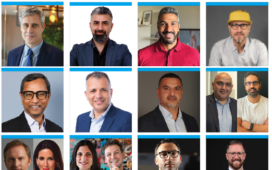A natural born curious, Luca Allam wonders what the future is made of.
Depending on your personality or your individual situation, the future is either a source of excitement or cause for anxiety. Either way it rarely leaves anyone indifferent. For businesses, it comes loaded with implications, particularly if they need to be ready to react to rapid changes. Knowing what’s ahead of us is important because no successful strategy has ever been conceived with eyes only focused on the past.
What makes the future so tough to predict is that the pace of change is quickening. We know it’s not linear and there is a debate whether it’s exponential, forever quickening, reaching a plateau after an exponential phase of growth. Add to this the concept of the point of singularity, where artificial intelligence will match first and then exceed human intelligence, and our tunnel vision gets increasingly dark.
This shouldn’t stop us from forging ahead. The more we embrace the changes ahead of us, the better placed we will be, actors rather than victims of the future. Evolution is unstoppable. Today we’re talking of extending life beyond 100 years using robotics and biotechnology. There is also evidence that our brains are being rewired as the result of the use of modern media, particularly among teens.
We got to this point in human evolution through curiosity, a degree of genius and a fair amount of luck. Curiosity is a key trait because it pushes us to wonder and explore, constantly wondering what the future holds. The only limit placed on what we can create is our own imagination and sense of perspective. When Twitter launched in 2007, many of us thought it was just a glorified form of text messaging because we looked at it through the prism of past and present technologies. Little did we realise that it was the start of a completely new form of communication – micro-blogging and live storytelling at a potentially global scale.
To be better prepared for what’s around the corner, we need to embrace and not fear technological advances we don’t necessarily comprehend just yet. Some predict that developments in genetics, nanotechnology and robotics (or artificial intelligence), collectively known as GNR, will create fundamental changes in humanity. Spike Jonze’s film ‘Her’, where people have intimate relationships with computer programmes, is one vision of this. Considering that many of us take our phones to bed and have separation anxiety when they forget them is a sign that reality could catch up with (science) fiction sooner than we think.
Having a vision of the future will help us make better strategic decisions today. Look, for instance, at wearable technology such as Fit-bit, Jawbone, Google Glass and Samsung Galaxy watches. We need to consider where this new wearable tech will go in a few years’ time. As a minimum, such devices will become a medical sensor that tell us if we are about to get seriously ill. More interestingly is if they develop the ability to tap into our brain waves and read our emotions, perhaps they will help to cheer us up. Some signs point to a rapid personalisation of brands, products and services, including visions of a more intimate connection with the physical person. Brain implants anyone?
The beauty of the future is that it is ours to make. In some cases, we will need to follow the trends, embracing the behavioural shifts and emerging technologies around us. In others, we can take a leading role, define a future perfect and develop it. Technology is an enabler, not a straight-jacket.
With the hype cycle, from launch to plateau, getting faster, technologies reach the more mature parts of the cycle more and more quickly. Brands and their agencies need to become much more focused on discerning what makes sense to them and their audiences, present and future, and imagine a way to capitalise on their promise. The first mover advantage has never been so critical and dithering is no longer
an option.
There has often been a lag between the adoption of new technologies by consumers and advertisers, the latter waiting for the evidence to mount before reacting. As the evolution becomes faster, waiting will eventually equate to falling behind.
It is therefore time to become more curious, more ambitious, braver and ready to act decisively. The notion of R&D in a media budget is rapidly becoming essential to a brand’s ability to innovate. Picking up trends early, testing opportunities out first or indeed creating them will allow advertisers to be and stay ahead of the curve in general and their competition in particular. Some argue that a couple of percentage points from the media budget can easily be earmarked for this testing. Just like brands are now developing war rooms, the next step is the media lab.
This doesn’t call for a radical shift today but a change of mind set, liberating both clients and their agencies from the shackles of the past and unbridling their thinking. The past should only serve for context and comparison, rather than be a stencil from which we design our future.
(Luca Allam is the general manager at PHD Dubai)










